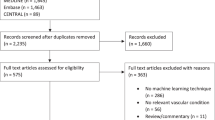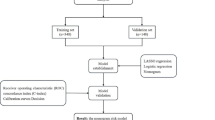Abstract
We developed a code and data-driven system (learning healthcare system) for gleaning actionable clinical insight from interventional radiology (IR) data. To this end, we constructed a workflow for the collection, processing and analysis of electronic health record (EHR), imaging, and cancer registry data for a cohort of interventional radiology patients seen in the IR Clinic at our institution over a more than 20-year period. As part of this pipeline, we created a database in REDCap (VITAL) to store raw data, as collected by a team of clinical investigators and the Data Coordinating Center at our university. We developed a single, universal pre-processing codebank for our VITAL data in R; in addition, we also wrote widely extendable and easily modifiable analysis code in R that presents results from summary statistics, statistical tests, visualizations, Kaplan-Meier analyses, and Cox proportional hazard modeling, among other analysis techniques. We present our findings for a test case of supra versus infra-inguinal ligament stenting. The developed pre-processing and analysis pipelines were memory and speed-efficient, with both pipelines running in less than 2 min. Three different supra-inguinal ligament veins had a statistically significant improvement in vein diameters post-stenting versus pre-stenting, while no infra-inguinal ligament veins had a statistically significant improvement (due either to an insufficient sample size or a non-significant p value). However, infra-inguinal ligament stenting was not associated with worse restenosis or patency outcomes in either a univariate (summary-statistics and Kaplan-Meier based) or multivariate (Cox proportional hazard model based) analysis.






Similar content being viewed by others
References
Babal E, Glbaran M, Grmen T, Oztürk S: Fracture of popliteal artery stents. Circ J 67(7):643645, 2003
Andrews RT, Venbrux AC, Magee CA, Bova DA: Placement of a flexible endovascular stent across the femoral joint: An in vivo study in the swine model. Vasc Interv Radiol 10(9):12191228, 1999
Ballard JL, Sparks SR, Taylor FC, Bergan JJ, Smith DC, Bunt TJ, Killeen JD: Complications of iliac artery stent deployment. Vasc Surg 24(4):545555, 1996
Neglén P, Tackett TP, Raju S: Venous stenting across the inguinal ligament. J Vasc Surg 48(5):12551261, 2008
Saha P, Gwozdz A, Hagley D, El-Sayed T, Hunt B, McDonald V, Cohen A, Breen K, Karunanithy N, Black S: Patency rates after stenting across the inguinal ligament for treatment of post-thrombotic syndrome using nitinol venous stents. J Vasc Surg Venous Lymphat Disord 5(1):148, 2017
Lowe HJ, Ferris TA, Hernandez PM, Weber SC: STRIDE- an integrated standards-based translational research informatics platform. AMIA Annu Symp Proc 2009:391–395, 2009
Harris PA, Taylor R, Thielke R, Payne J, Gonzalez N, Conde JG: Research electronic data capture (REDCap) – A metadata-driven methodology and workflow process for providing translational research informatics support. J Biomed Inform 42(2):377–381, 2009
Cancer Institute Research Database (SCIRDB) Overview. Available at https://med.stanford.edu/dbds/cool-tools/research-informatics-center/scrirdb.html. Accessed 5 April 2019.
Wickham H, Francios R, Henry L, Muller K.: Dplyr: A fast, consistent tool for working with data frame like objects, both in memory and out of memory. R package version 0.7.6. R Found Stat Comput, 2014.
Wickham H, Henry L: Tidyr: An evoluation of reshape2. Its designed specifically for data tidying (not general reshaping or aggregating) and works well with dplyr data pipelines. R package version 0.8.1. R Found Stat Comput, R Core Team, 2014.
R: A language and environment for statistical computing. R Found Stat. Comput.
Pre-processing GitHub Codebase. Available at https://github.com/LearningHealthcare/VITAL_Pre_Processing_Codebase. Accessed 21 August 2019.
Data Analysis GitHub Codebase. Available at https://github.com/LearningHealthcare/Inguinal_Ligament_Analysis_Codebase. Accessed 21 August 2019.
Therneau T, Lumley T: Survival: Survival analysis, including penalised likelihood. R package version 2.42–6 R found stat Comput, 2009.
Prinja S, Gupta N, Verma R: Censoring in clinical trials: Review of survival analysis techniques. Indian J Community Med 35(2):217221, 2010
Mantel N: Evaluation of survival data and two new rank order statistics arising in its consideration. Cancer Chemother Rep. 50(3):16370, 1966
Wickham H, Chang W : ggplot2: Create elegant data Visualisations using the grammar of graphics. R package version 3.0.0 R found stat Comput, 2007.
RStudio Desktop. Available at rstudio.com/products/rstudio/#Desktop. Accessed 19 August 2019.
Vedantham S, Grassi CJ, Ferral H, Patel NH, Thorpe PE, Antonacci VP, Janne d’Othée BM, Hofmann LV, Cardella JF, Kundu S, Lewis CA, Schwartzberg MS, Min RJ, Sacks D: Reporting standards for endovascular treatment of lower extremity deep vein thrombosis. J Vasc Interv Radiol 20(7):S391S408, 2009
Funding
This research was funded by the Stanford Medical Scholars Program, as well as the Stanford University Department of Radiology, CHA University Bundang Medical Center and Shanghai General Hospital in the form of salary support for D.M.C., G.S.J, and X.A., respectively.
Author information
Authors and Affiliations
Corresponding author
Ethics declarations
L.V.H. is a consultant for Cook Medical and has received royalties and/or equity payouts from Cook Medical, Boston Scientific, Medtronic and Confluent Medical. L.V.H. is also a co-founder, current member of the Board of Directors, and has equity at Grand Rounds. W.K. is a consultant for Walk Vascular. D.Y.S. is/has been a consultant for the following companies in the last 3 years: Astra-Zeneca, Bayer, BlackSwan Vascular, Boston Scientific, Bristol Myers Squibb, BTG, Eisai, EmbolX, W. L. Gore, Janssen, Koli Medical, RadiAction Medical, Terumo. In addition, D.Y.S. has/has received equity from Confluent Medical and Proteus Digital Health. Finally, D.Y.S. has/has had institutional support in the last 3 years from BTG, W. L. Gore, Merit Medical, and Sirtex.
We received Institutional Review Board approval at our institution. For this retrospective study, formal consent was not required. This article does not contain any studies with animals performed by any of the authors.
This work has been previously published as a pre-print on Research Gate at the following URL:
We have made subsequent edits to the paper that was pre-printed to Research Gate to arrive at the paper draft in its current form.
Additional information
Publisher’s Note
Springer Nature remains neutral with regard to jurisdictional claims in published maps and institutional affiliations.
IRB: Approved by Stanford IRB, VITAL #33192
Rights and permissions
About this article
Cite this article
Cohn, D.M., Mabud, T.S., Arendt, V.A. et al. Toward Data-Driven Learning Healthcare Systems in Interventional Radiology: Implementation to Evaluate Venous Stent Patency. J Digit Imaging 33, 25–36 (2020). https://doi.org/10.1007/s10278-019-00280-6
Published:
Issue Date:
DOI: https://doi.org/10.1007/s10278-019-00280-6




